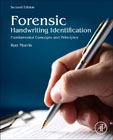
Forensic Handwriting Identification: Fundamental Concepts and Principles
Morris, Ron N.
Forensic Handwriting Identification teaches the law enforcement and legal communities the major principles involved in handwriting and hand-printing analysis as applied to many types of investigation: fraud, homicide, suicide, drug trafficking/clandestine labs, sexual offenses, threats and extortion, blackmail, arson, bombings, and theft. Lawyers and investigators learn about interpreting an examiner's report, the significance of various handwriting opinions and the influencing factors which must be considered. Students of document examination will gain much from such a practical, yet rigorously scientific, treatment of the subject. Reviews basic concepts that affect a person's writing, demonstrates how to obtain handwriting specimens and evidence, provides the appropriate ASTM and SWIGDOC standards and proceduresIdeally suited for forensic science and legal professionals, investigators working with document examiners, and law enforcement students and professionalsIncludes model specimen handwriting forms INDICE: 1. Physiology of Writing 2. Handwriting Systems 3. Class Characteristics 4. Individuality and Individual Characteristics 5. Characteristics, Qualities, and Features of Writing 6. Relative Speed of Writing and Writing Skill 7. Ratios or Relative Relationships 8. Beginning, Connecting and Ending Strokes 9. Writing Instruments 10. General Observations 11. The Process of Comparison 12. Abnormal/Disguised Writing 13. Obtaining Handwriting Samples 14. Submitting a case to the lab 15. Examiner's Final Report
- ISBN: 978-0-12-409602-8
- Editorial: Academic Press
- Encuadernacion: Cartoné
- Páginas: 312
- Fecha Publicación: 01/11/2020
- Nº Volúmenes: 1
- Idioma: Inglés
